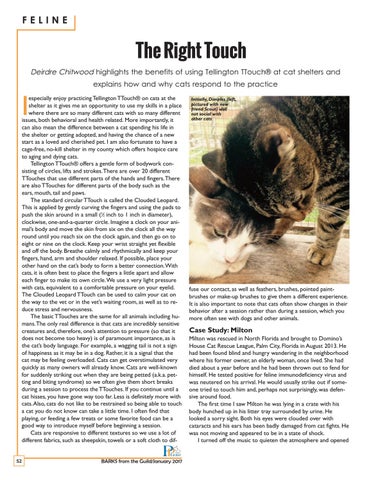FELINE
I
The Right Touch
Deirdre Chitwood highlights the benefits of using Tellington TTouch® at cat shelters and explains how and why cats respond to the practice
especially enjoy practicing Tellington TTouch® on cats at the shelter as it gives me an opportunity to use my skills in a place where there are so many different cats with so many different issues, both behavioral and health related. More importantly, it can also mean the difference between a cat spending his life in the shelter or getting adopted, and having the chance of a new start as a loved and cherished pet. I am also fortunate to have a cage-free, no-kill shelter in my county which offers hospice care to aging and dying cats. Tellington TTouch® offers a gentle form of bodywork consisting of circles, lifts and strokes. There are over 20 different TTouches that use different parts of the hands and fingers. There are also TTouches for different parts of the body such as the ears, mouth, tail and paws. The standard circular TTouch is called the Clouded Leopard. This is applied by gently curving the fingers and using the pads to push the skin around in a small (1⁄2 inch to 1 inch in diameter), clockwise, one-and-a-quarter circle. Imagine a clock on your animal’s body and move the skin from six on the clock all the way round until you reach six on the clock again, and then go on to eight or nine on the clock. Keep your wrist straight yet flexible and off the body. Breathe calmly and rhythmically and keep your fingers, hand, arm and shoulder relaxed. If possible, place your other hand on the cat’s body to form a better connection. With cats, it is often best to place the fingers a little apart and allow each finger to make its own circle. We use a very light pressure with cats, equivalent to a comfortable pressure on your eyelid. The Clouded Leopard TTouch can be used to calm your cat on the way to the vet or in the vet’s waiting room, as well as to reduce stress and nervousness. The basic TTouches are the same for all animals including humans. The only real difference is that cats are incredibly sensitive creatures and, therefore, one’s attention to pressure (so that it does not become too heavy) is of paramount importance, as is the cat’s body language. For example, a wagging tail is not a sign of happiness as it may be in a dog. Rather, it is a signal that the cat may be feeling overloaded. Cats can get overstimulated very quickly as many owners will already know. Cats are well-known for suddenly striking out when they are being petted (a.k.a. petting and biting syndrome) so we often give them short breaks during a session to process the TTouches. If you continue until a cat hisses, you have gone way too far. Less is definitely more with cats. Also, cats do not like to be restrained so being able to touch a cat you do not know can take a little time. I often find that playing, or feeding a few treats or some favorite food can be a good way to introduce myself before beginning a session. Cats are responsive to different textures so we use a lot of different fabrics, such as sheepskin, towels or a soft cloth to dif52
BARKS from the Guild/January 2017
Initially, Dimples (left, pictured with new friend Scout) was not social with other cats
fuse our contact, as well as feathers, brushes, pointed paintbrushes or make-up brushes to give them a different experience. It is also important to note that cats often show changes in their behavior after a session rather than during a session, which you more often see with dogs and other animals.
Case Study: Milton
Milton was rescued in North Florida and brought to Domino’s House Cat Rescue League, Palm City, Florida in August 2013. He had been found blind and hungry wandering in the neighborhood where his former owner, an elderly woman, once lived. She had died about a year before and he had been thrown out to fend for himself. He tested positive for feline immunodeficiency virus and was neutered on his arrival. He would usually strike out if someone tried to touch him and, perhaps not surprisingly, was defensive around food. The first time I saw Milton he was lying in a crate with his body hunched up in his litter tray surrounded by urine. He looked a sorry sight. Both his eyes were clouded over with cataracts and his ears has been badly damaged from cat fights. He was not moving and appeared to be in a state of shock. I turned off the music to quieten the atmosphere and opened
